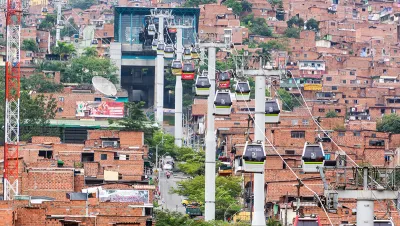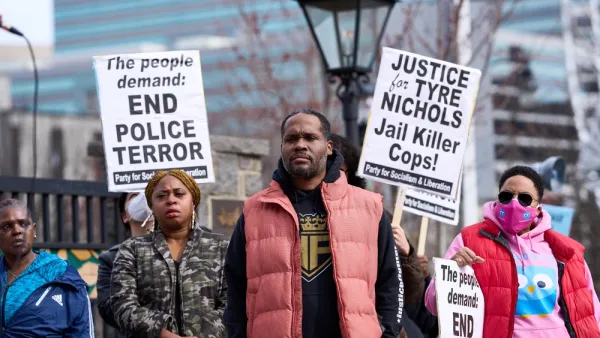A natural experiment in Medellín indicates that infrastructural investments can reduce crime and improve perceptions of public safety.

Writing in Streetsblog Chicago, Courtney Cobbs describes a 2012 analysis of how the built environment can affect violence and societal trust in Medellín, Colombia, and the lessons it provides for U.S. cities like Chicago. The study compared two neighborhoods, one that received infrastructure improvements and one that did not, to see how those improvements affected crime rates and community trust.
As part of the city's development plan, Medellín installed a network of gondolas known as Metrocable, which shuttle residents up and down the city's steep hillsides. In neighborhoods served by Metrocable, the government also installed "additional lighting for public spaces; new pedestrian bridges and street paths; 'library parks' (combining a library building and parkland); new buildings for schools, recreational centers, and centers to promote microenterprises; more police patrols; and a family police station (focusing on the protection of women and children) next to a gondola station." In other words, the gondola was accompanied by a system of public amenities, supportive infrastructure, and social services.
In the research period of 2003 to 2012, homicide rates and perceived violence dropped in all of Medellín's neighborhoods, but dropped more sharply in the neighborhoods with the gondola and new amenities. According to Cobbs, "Belief that residents could have a positive impact on reducing crime, and look out for one another in their neighborhood, increased in the intervention group but stayed stable for the control group."
The results indicate that "people-centered" infrastructure investments, while not a silver bullet, can have an impact on public safety and social cohesion, and Cobbs calls for similar investments in Chicago's underserved South and West sides.
FULL STORY: Notes from Medellín: Can infrastructure investments help reduce interpersonal violence?

Analysis: Cybertruck Fatality Rate Far Exceeds That of Ford Pinto
The Tesla Cybertruck was recalled seven times last year.

National Parks Layoffs Will Cause Communities to Lose Billions
Thousands of essential park workers were laid off this week, just before the busy spring break season.

Retro-silient?: America’s First “Eco-burb,” The Woodlands Turns 50
A master-planned community north of Houston offers lessons on green infrastructure and resilient design, but falls short of its founder’s lofty affordability and walkability goals.

Test News Post 1
This is a summary

Analysis: Cybertruck Fatality Rate Far Exceeds That of Ford Pinto
The Tesla Cybertruck was recalled seven times last year.

Test News Headline 46
Test for the image on the front page.
Urban Design for Planners 1: Software Tools
This six-course series explores essential urban design concepts using open source software and equips planners with the tools they need to participate fully in the urban design process.
Planning for Universal Design
Learn the tools for implementing Universal Design in planning regulations.
EMC Planning Group, Inc.
Planetizen
Planetizen
Mpact (formerly Rail~Volution)
Great Falls Development Authority, Inc.
HUDs Office of Policy Development and Research
NYU Wagner Graduate School of Public Service



























